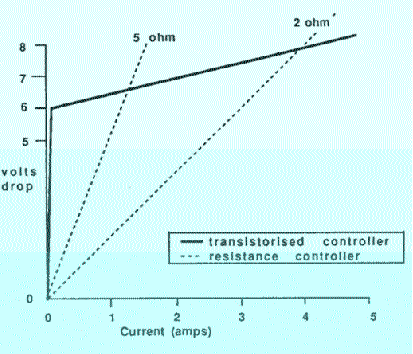Electronic Controllers
What's different?
Looking at the graph, doubling the current changes the transistorized controllers voltage drop by 10-15% for circuits using a Darlington pair (like the "normal British" circuit) and perhaps more with some single transistor circuits).
A second car on your lane isn't likely to be very noticeable switching type transistorized controllers.
Doubling the current changes the resistance controllers voltage drop by 50% so the second car on your lane is much more noticeable.
Resistance controllers and switching type transistorized controllers are less sensitive to fluctuations in power supply voltage.
(Hopefully today’s tracks have fairly consistent power supplies so this is not as noticeable as it used to be.)
A diode only passes current one way, but some diode controllers use pairs of diodes (bridge rectifiers) so that they will work either way round. It is much less likely that a diode will be damaged by connecting it the wrong way round. (But follow the manufactures instructions - better safe than get an unexpected big bang!)
vi
The step
between the
bottom band
of a normal
transistorized controller and full power
is quite large. The
ones I've measured using
a Darlington pair (like the "normal British"
circuit) show
about 2 volts. The minimum
size of this step is limited
by the transistor, it may be
possible to choose resistor values to reduce
it to about 1.4 volts.
Other circuits (like the Paul
Bucknell design or the NPN
one I've described or circuits using MOSFETs)
can halve the size of this bottom step. In some circumstances
a large
bottom step
could be
an advantage, but there may be an advantage in being able to adjust
this value which is exactly what the "choke" control on some controllers
does.
A large bottom step may not be a good idea for almost but not quite flat
out corners sometimes found on raceways - you just might want to drive
with less than full power but more than the bottom step allows you.
A diode controller will have a bottom step of about 0,7 volts
or 1,4 volts depending on if it has I or 2 diodes in the circuit.
Switching
type transistorized controllers generally use a completely different type
of transistor (called a MOSFET) which allow the bottom step to
be very small.
viii When the car is trying to pick up through a film
of oxide on the tapes, so there is no current flowing for an instant, what
you need is as many volts as possible to
break down
the oxide.
A controller that
applies the
full power
supply voltage in these conditions, even when your thumb (or
finger) is part way down, can
be a significant advantage. Some of
the early
attempts at
transistorized controllers didn't do this and caused the cars to be
more sensitive to bad pick up. As the graph shows,
this circuit
does not
suffer from
this problem. Switching
type transistorized controllers don't suffer from this problem.
(This is a
potential problem with some diode controllers.)
